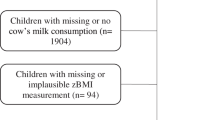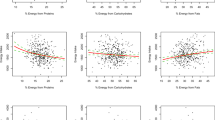Abstract
Background/objectives:
Few studies have investigated the associations between flavored milk consumption and body composition in children. We aimed to examine the prospective relationships between flavored milk consumption and body fat.
Subjects/methods:
Subjects included 2270 children from the Avon Longitudinal Study of Parents and Children. Flavored milk consumption at age 10 years was assessed using dietary records; consumption was dichotomized as consumers and non-consumers. Percent body fat was measured using dual-energy X-ray absorptiometry at 11 and 13 years. Body weight at 11 and 13 years was included as a secondary outcome. Associations were also examined in a subset of plausible reporters to evaluate the influence of dietary reporting errors. There was an effect of interaction between flavored milk and baseline weight on body fat (P-interaction <0.02).
Results:
In plausible reporters, overweight/obese children who consumed flavored milk had less favorable changes in body fat compared with non-consumers (adjusted means: −0.16%, 95% CI: −3.8, 3.5 vs −3.4%, 95% CI: −6.5, −0.42, P=0.02). Similar associations with body weight were observed. The adjusted mean percent body fat for overweight/obese girls who consumed flavored milk was greater at age 13 compared with 11 years (39.7%, 95% CI: 32, 47 vs 38.3%, 95% CI: 32, 44). The mean percent body fat for overweight/obese boys was similar between consumers and non-consumer is at 13 years (30.4%, 95% CI: 20, 41 vs 30.1%, 95% CI: 21, 40).
Conclusions:
Overweight/obese children who consumed flavored milk had less favorable changes in body composition over time. Although more research is needed, discouraging flavored milk consumption may be one beneficial strategy to address childhood obesity.
This is a preview of subscription content, access via your institution
Access options
Subscribe to this journal
Receive 12 print issues and online access
$259.00 per year
only $21.58 per issue
Buy this article
- Purchase on Springer Link
- Instant access to full article PDF
Prices may be subject to local taxes which are calculated during checkout


Similar content being viewed by others
References
Household Food Consumption Great Britain, 1974–2000. Available at http://www.statistics.gov.uk/StatBase/Expodata/Spreadsheets/D3802.xls (accessed on 22 March 2011).
Nielsen SJ, Popkin BM . Changes in beverage intake between 1977 and 2001. Am J Prev Med 2004; 27: 205–210.
Wang Y, Lobstein T . Worldwide trends in childhood overweight and obesity. Int J Pediatr Obes 2006; 1: 11–25.
Ogden CL, Carroll MD, Curtin LR, Lamb MM, Flegal KM . Prevalence of high body mass index in US children and adolescents, 2007–2008. JAMA 2006; 303: 242–249.
Bates B, Lennox A, Swan G National Diet and Nutrition Survey: Headline Results from Year 1 of the Rolling Programme (2008/2009), 2010 Available at: http://www.food.gov.uk/multimedia/pdfs/publication/ndnsreport0809.pdf (accessed on 23 March 2011).
Bachman JL, Reedy J, Subar AF, Krebs-Smith SM . Sources of food group intakes among the US population, 2001–2002. J Am Diet Assoc 2008; 108: 804–814.
Weinberg LG, Berner LA, Groves JE . Nutrient contributions of dairy foods in the United States, continuing survey of food intakes by individuals, 1994–1996, 1998. J Am Diet Assoc 2004; 104: 895–902.
Moore LL, Bradlee ML, Gao D, Singer MR . Effects of average childhood dairy intake on adolescent bone health. J Pediatr 2008; 153: 667–673.
Weaver CM . Role of dairy beverages in the diet. Physiol Behav 2010; 100: 63–66.
Raimondi S, Mabrouk JB, Shatenstein B, Maisonneuve P, Ghadirian P . Diet and prostate cancer risk with specific focus on dairy products and dietary calcium: a case–control study. Prostate 2010; 70: 1054–1065.
Gonzalez CA, Riboli E . Diet and cancer prevention: Contributions from the European Prospective Investigation into Cancer and Nutrition (EPIC) study. Eur J Cancer 2010; 46: 2555–2562.
Larsson SC, Bergkvist L, Wolk A . Milk and lactose intakes and ovarian cancer risk in the Swedish Mammography Cohort. Am J Clin Nutr 2004; 80: 1353–1357.
Barba G, Troiano E, Russo P, Venezia A, Siani A . Inverse association between body mass and frequency of milk consumption in children. Br J Nutr 2005; 93: 15–19.
Johnson L, Mander AP, Jones LR, Emmett PM, Jebb SA . Is sugar-sweetened beverage consumption associated with increased fatness in children? Nutrition 2007; 23: 557–563.
Vanselow MS, Pereira MA, Neumark-Sztainer D, Raatz SK . Adolescent beverage habits and changes in weight over time: findings from Project EAT. Am J Clin Nutr 2009; 90: 1489–1495.
Murphy MM, Douglass JS, Johnson RK, Spence LA . Drinking flavored or plain milk is positively associated with nutrient intake and is not associated with adverse effects on weight status in US children and adolescents. J Am Diet Assoc 2008; 108: 631–639.
USDA National Nutrient Database for Standard Reference, Release 23. Nutrient Data Laboratory Home Page. US Department of Agriculture, Agricultural Research Service. Available at http://www.nal.usda.gov/fnic/foodcomp/search/ (accessed on 20 December 2010).
Johnson RK, Frary C, Wang MQ . The nutritional consequences of flavored-milk consumption by school-aged children and adolescents in the United States. J Am Diet Assoc 2002; 102: 853–856.
Malik VS, Schulze MB, Hu FB . Intake of sugar-sweetened beverages and weight gain: a systematic review. Am J Clin Nutr 2006; 84: 274–288.
Golding J, Pembrey M, Jones R . ALSPAC—the Avon Longitudinal Study of Parents and Children. I. Study methodology. Paediatr Perinat Epidemiol 2001; 15: 74–87.
Price GM, Paul AA, Key FB, Harter AC, Cole TJ, Day KC et al. Measurement of diet in a large national survey: comparison of computerized and manual coding of records in household measures. J Hum Nutr Diet 1995; 8: 417–428.
Holland B, Welch AA, Unwin ID, Buss DH, Paul AA, Southgate DAT (eds). McCance & Widdowson’s The Composition of Foods. 5th edn., The Royal Society of Chemistry: Cambridge, 1991.
Gregory J, Lowe S National Diet and Nutrition Survey: Young People Aged 4 to 18 Years. Volume 1: Report of the diet and nutrition survey. The Stationery Office: London, 2000.
Centers for Disease Control and Prevention National Center for Health Statistics 2000 CDC Growth Charts: United States. Available at: http://www.cdc.gov/growthcharts (accessed on 5 October 2011).
Noel SE, Mattocks C, Emmett P, Riddoch CJ, Ness AR, Newby P . Use of accelerometer data in prediction equations for capturing implausible dietary intakes in adolescents. Am J Clin Nutr 2010; 92: 1436–1445.
Huang TT, Howarth NC, Lin BH, Roberts SB, McCrory MA . Energy intake and meal portions: associations with BMI percentile in U.S. children. Obes Res 2004; 12: 1875–1885.
Riddoch CJ, Leary SD, Ness AR, Blair SN, Deere K, Mattocks C et al. Prospective associations between objective measures of physical activity and fat mass in 12–14 year old children: the Avon Longitudinal Study of Parents and Children (ALSPAC). BMJ 2009; 339: b4544.
Ness AR, Leary SD, Mattocks C, Blair SN, Reilly JJ, Wells J et al. Objectively measured physical activity and fat mass in a large cohort of children. PLoS Med 2007; 4: e97.
Huh SY, Rifas-Shiman SL, Rich-Edwards JW, Taveras EM, Gillman MW . Prospective association between milk intake and adiposity in preschool-aged children. J Am Diet Assoc 2010; 110: 563–570.
Fiorito LM, Marini M, Francis LA, Smiciklas-Wright H, Birch LL . Beverage intake of girls at age 5y predicts adiposity and weight status in childhood and adolescence. Am J Clin Nutr 2009; 90: 935–942.
Newby PK, Peterson KE, Berkey CS, Leppert J, Willett WC, Colditz GA . Beverage consumption is not associated with changes in weight and body mass index among low-income preschool children in North Dakota. J Am Diet Assoc 2004; 104: 1086–1094.
O’Connor TM, Yang SJ, Nicklas TA . Beverage intake among preschool children and its effect on weight status. Pediatrics 2006; 118: e1010–e1018.
Noel SE, Ness A, Northstone K, Emmett P, Newby PK . Milk intakes are not associated with percent body fat in children from ages 10 to 13 years. J Nutr 2011; 141: 2035–2041.
Berkey CS, Rockett HR, Willett WC, Colditz GA . Milk, dairy fat, dietary calcium, and weight gain: a longitudinal study of adolescents. Arch Pediatr Adolesc Med 2005; 159: 543–550.
Van Loan M . The role of dairy foods and dietary calcium in weight management. J Am Coll Nutr 2009; 28 (Suppl 1), 120S–129S.
Chan GM, Hoffman K, McMurry M . Effects of dairy products on bone and body composition in pubertal girls. J Pediatr 1995; 126: 551–556.
St-Onge MP, Goree LL, Gower B . High-milk supplementation with healthy diet counseling does not affect weight loss but ameliorates insulin action compared with low-milk supplementation in overweight children. J Nutr 2009; 139: 933–938.
Merrilees MJ, Smart EJ, Gilchrist NL, Frampton C, Turner JG, Hooke E et al. Effects of diary food supplements on bone mineral density in teenage girls. Eur J Nutr 2000; 39: 256–262.
Faith MS, Dennison BA, Edmunds LS, Stratton HH . Fruit juice intake predicts increased adiposity gain in children from low-income families: weight status-by-environment interaction. Pediatrics 2006; 118: 2066–2075.
Welsh JA, Cogswell ME, Rogers S, Rockett H, Mei Z, Grummer-Strawn LM . Overweight among low-income preschool children associated with the consumption of sweet drinks: Missouri, 1999–2002. Pediatrics 2005; 115 (2), e223–e229.
Newby PK, Weismayer C, Akesson A, Tucker KL, Wolk A . Longitudinal changes in food patterns predict changes in weight and body mass index and the effects are greatest in obese women. J Nutr 2006; 136: 2580–2587.
Nowak M . The weight-conscious adolescent: body image, food intake, and weight-related behavior. J Adolesc Health 1998; 23: 389–398.
Neumark-Sztainer D, Hannan PJ, Story M, Perry CL . Weight-control behaviors among adolescent girls and boys: implications for dietary intake. J Am Diet Assoc 2004; 104: 913–920.
Story M, Neumark-Sztainer D, Sherwood N, Stang J, Murray D . Dieting status and its relationship to eating and physical activity behaviors in a representative sample of US adolescents. J Am Diet Assoc 1998; 98: 1127–1135., 1255.
Larson NI, Neumark-Sztainer D, Story M . Weight control behaviors and dietary intake among adolescents and young adults: longitudinal findings from Project Eat. J Am Diet Assoc 2009; 109: 1869–1877.
Ross AC, Manson JE, Abrams SA, Aloia JF, Brannon PM, Clinton SK et al. The 2011 report on dietary reference intakes for calcium and vitamin D from the Institute of Medicine: what clinicians need to know. J Clin Endocrinol Metab 2011; 96: 53–58.
Acknowledgements
We are appreciative of the families who participated in this study, the midwives for their help in recruiting participants and the ALSPAC study team. This work was supported by the American Diabetes Association (7-08-JF-41). The UK Medical Research Council, the Wellcome Trust and the University of Bristol provide support for the ALSPAC study. Physical activity assessment and other measures were funded by grants from the National Heart, Lung and Blood Institute (R01 HL071248-01A). This work was supported by the American Diabetes Association (7-08-JF-41). In addition, the UK Medical Research Council, the Wellcome Trust and the University of Bristol provided support for the ALSPAC study. Physical activity assessment and other measures were funded by grants from the National Heart, Lung and Blood Institute (R01 HL071248-01A).
Author information
Authors and Affiliations
Corresponding author
Ethics declarations
Competing interests
The authors declare no conflict of interest.
Additional information
Supplementary Information accompanies the paper on European Journal of Clinical Nutrition website
Supplementary information
Rights and permissions
About this article
Cite this article
Noel, S., Ness, A., Northstone, K. et al. Associations between flavored milk consumption and changes in weight and body composition over time: differences among normal and overweight children. Eur J Clin Nutr 67, 295–300 (2013). https://doi.org/10.1038/ejcn.2012.123
Received:
Revised:
Accepted:
Published:
Issue Date:
DOI: https://doi.org/10.1038/ejcn.2012.123
Keywords
This article is cited by
-
Age and time trends of dairy intake among children and adolescents of the DONALD study
European Journal of Nutrition (2021)
-
Dietary fats and cardiometabolic disease: mechanisms and effects on risk factors and outcomes
Nature Reviews Cardiology (2019)
-
Dairy products and total calcium intake at 13 years of age and its association with obesity at 21 years of age
European Journal of Clinical Nutrition (2018)
-
Long-term association between dairy consumption and risk of childhood obesity: a systematic review and meta-analysis of prospective cohort studies
European Journal of Clinical Nutrition (2016)



